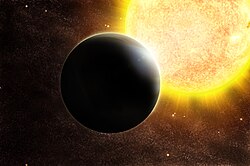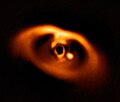
An extragalactic planet, also known as an extragalactic exoplanet or an extroplanet, [1] [2] [3] is a star-bound planet or rogue planet located outside of the Milky Way Galaxy. Due to the immense distances to such worlds, they have been very hard to detect directly. However, indirect evidences suggest that such planets exist. [4] [5] [6] [7] [8] Nonetheless, the most distant individually confirmed planets are SWEEPS-11 and SWEEPS-04, located in Sagittarius, approximately 27,710 light-years from the Sun, while the Milky Way is about 87,400 light-years in diameter. This means that even galactic planets located further than that distance have not been individually confirmed.
Contents
- Confirmed extragalactic planets
- Confirmed from gravitational microlensing
- Candidate extragalactic planets
- Candidates from gravitational microlensing
- Candidates around extragalactic black-holes and X-ray binaries
- Candidates around formerly extragalactic stars
- Refuted extragalactic planets
- HIP 13044 b
- See also
- References
- External links

